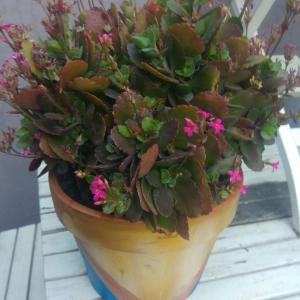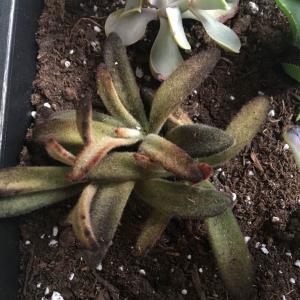成长记
taramisue
2017年10月07日

I new added a "Kalanchoe delagoensis, Chandelier Plant" in my "garden"


0
0
文章
Dummer. ゛☀
2017年10月02日

Scientific Name
Kalanchoe prolifera (Bow.) R.-Hamet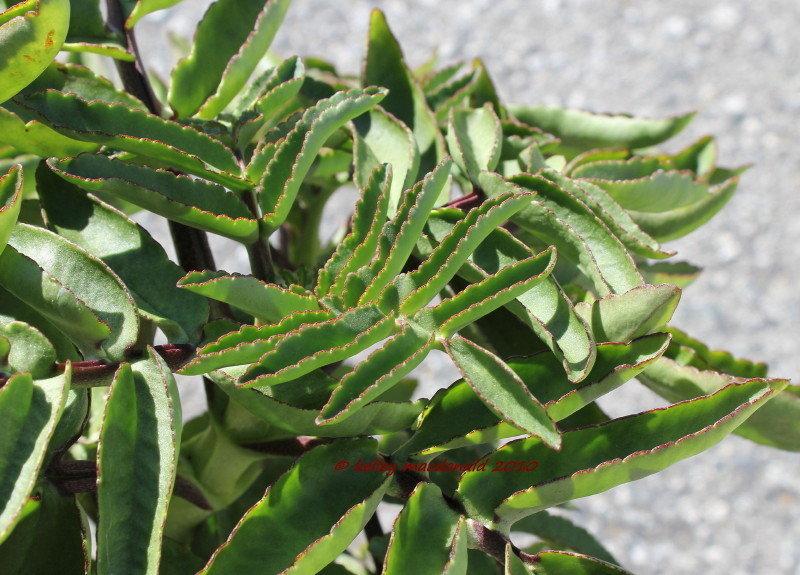
Common Names
Blooming Boxes
Synonyms
Bryophyllum proliferum
Scientific Classification
Family: Crassulaceae
Subfamily: Sedoideae
Tribe: Kalanchoeae
Genus: Kalanchoe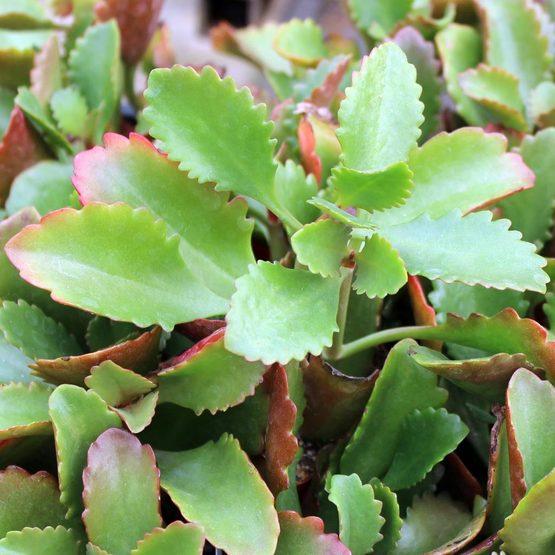
Description
Kalanchoe prolifera is a fast growing and interesting succulent plant with up to 6 feet (1.8 m) tall, typically unbranched stems holding foot (30 cm) long pinnately compound succulent green leaves in opposite pairs that have reddish purple colored petioles and leaf margins when grown in bright light. As the leaves drop the stem has interesting leaf scar bands along the thick stem, which as the plant matures after several years, is topped with 3 foot (90 cm) tall panicle of greenish orange flowers in late winter – the green calyces of the flower are box shaped and nearly hide the pale orange petals. The plant declines after flowering but many new plantlets form in the inflorescence and the main plant will often sucker up with a new stem so a colony is easy to establish.
How to Grow and Care
Kalanchoes are not particularly hard to grow, and the flowering varieties are highly rewarding for their colorful and long-lasting flowers. They prefer bright, sunny locations, especially in the summer growing season. During the winter, consider a south-facing window. Water moderately throughout the summer and reduce watering in the winter. Let the soil surface dry out between waterings, and in the winter, the plant can almost dry out. Watch the fleshy leaves for signs of water distress. They prefer warmth. Do not let fall below 55ºF (12.7ºC). An ordinary potting soil mix is fine. Feed bi-weekly in the summer with a liquid fertilizer, or use slow-release pellets.
Kalanchoe prolifera (Bow.) R.-Hamet

Common Names
Blooming Boxes
Synonyms
Bryophyllum proliferum
Scientific Classification
Family: Crassulaceae
Subfamily: Sedoideae
Tribe: Kalanchoeae
Genus: Kalanchoe

Description
Kalanchoe prolifera is a fast growing and interesting succulent plant with up to 6 feet (1.8 m) tall, typically unbranched stems holding foot (30 cm) long pinnately compound succulent green leaves in opposite pairs that have reddish purple colored petioles and leaf margins when grown in bright light. As the leaves drop the stem has interesting leaf scar bands along the thick stem, which as the plant matures after several years, is topped with 3 foot (90 cm) tall panicle of greenish orange flowers in late winter – the green calyces of the flower are box shaped and nearly hide the pale orange petals. The plant declines after flowering but many new plantlets form in the inflorescence and the main plant will often sucker up with a new stem so a colony is easy to establish.

How to Grow and Care
Kalanchoes are not particularly hard to grow, and the flowering varieties are highly rewarding for their colorful and long-lasting flowers. They prefer bright, sunny locations, especially in the summer growing season. During the winter, consider a south-facing window. Water moderately throughout the summer and reduce watering in the winter. Let the soil surface dry out between waterings, and in the winter, the plant can almost dry out. Watch the fleshy leaves for signs of water distress. They prefer warmth. Do not let fall below 55ºF (12.7ºC). An ordinary potting soil mix is fine. Feed bi-weekly in the summer with a liquid fertilizer, or use slow-release pellets.
1
0
文章
Dummer. ゛☀
2017年10月01日

Scientific Name
Kalanchoe manginii Raym.-Hamet & H. Perrier
Common Names
Chandelier Plant, Beach Bells
Synonyms
Bryophyllum manginii
Scientific Classification
Family: Crassulaceae
Subfamily: Sedoideae
Tribe: Kalanchoeae
Genus: Kalanchoe
Description
Kalanchoe manginii is an evergreen succulent perennial growing up to 12 inches (30 cm) tall and wide, with arching branches of rounded, glossy leaves. It bears few flowered, cyme like panicles of tubular, urn-shaped, red flowers, up to 1.2 inches (3 cm) or more long.
How to Grow and Care
Kalanchoes are not particularly hard to grow, and the flowering varieties are highly rewarding for their colorful and long-lasting flowers. They prefer bright, sunny locations, especially in the summer growing season. During the winter, consider a south-facing window. Water moderately throughout the summer and reduce watering in the winter. Let the soil surface dry out between waterings, and in the winter, the plant can almost dry out. Watch the fleshy leaves for signs of water distress. They prefer warmth. Do not let fall below 55ºF (12.7ºC). An ordinary potting soil mix is fine. Feed bi-weekly in the summer with a liquid fertilizer, or use slow-release pellets.
Kalanchoe manginii Raym.-Hamet & H. Perrier
Common Names
Chandelier Plant, Beach Bells
Synonyms
Bryophyllum manginii
Scientific Classification
Family: Crassulaceae
Subfamily: Sedoideae
Tribe: Kalanchoeae
Genus: Kalanchoe

Description
Kalanchoe manginii is an evergreen succulent perennial growing up to 12 inches (30 cm) tall and wide, with arching branches of rounded, glossy leaves. It bears few flowered, cyme like panicles of tubular, urn-shaped, red flowers, up to 1.2 inches (3 cm) or more long.

How to Grow and Care
Kalanchoes are not particularly hard to grow, and the flowering varieties are highly rewarding for their colorful and long-lasting flowers. They prefer bright, sunny locations, especially in the summer growing season. During the winter, consider a south-facing window. Water moderately throughout the summer and reduce watering in the winter. Let the soil surface dry out between waterings, and in the winter, the plant can almost dry out. Watch the fleshy leaves for signs of water distress. They prefer warmth. Do not let fall below 55ºF (12.7ºC). An ordinary potting soil mix is fine. Feed bi-weekly in the summer with a liquid fertilizer, or use slow-release pellets.
0
0
文章
Dummer. ゛☀
2017年10月01日

Scientific Name
Kalanchoe daigremontiana Raym.-Hamet & H. Perrier
Common Names
Mother of Thousands, Alligator Plant, Devil’s Backbone, Mexican Hat Plant
Synonyms
Bryophyllum daigremontianum, Kalanchoe daigremontianum
Scientific Classification
Family: Crassulaceae
Subfamily: Sedoideae
Tribe: Kalanchoeae
Genus: Kalanchoe
Description
Kalanchoe daigremontiana is an upright succulent perennial, up to 3 feet (1 m) tall, with opposite, fleshy oblong-lanceolate, grey-green leaves, often spotted with brown-red and with a row of plantlets on each edge. The plantlets form roots while on the plant. The leaves reach up to 8 inches (20 cm) long and up to 1.2 inches (3 cm) wide. The flowers are tubular, greyish pink in color, up to 1 inch (2.5 cm) long.
Hardiness
USDA hardiness zone 9b to 11b: from 25 °F (−3.9 °C) to 50 °F (+10 °C).
How to Grow and Care
Kalanchoes are not particularly hard to grow, and the flowering varieties are highly rewarding for their colorful and long-lasting flowers. They prefer bright, sunny locations, especially in the summer growing season. During the winter, consider a south-facing window. Water moderately throughout the summer and reduce watering in the winter. Let the soil surface dry out between waterings, and in the winter, the plant can almost dry out. Watch the fleshy leaves for signs of water distress. They prefer warmth. Do not let fall below 55ºF (12.7ºC). An ordinary potting soil mix is fine. Feed bi-weekly in the summer with a liquid fertilizer, or use slow-release pellets.
Kalanchoe daigremontiana Raym.-Hamet & H. Perrier

Common Names
Mother of Thousands, Alligator Plant, Devil’s Backbone, Mexican Hat Plant
Synonyms
Bryophyllum daigremontianum, Kalanchoe daigremontianum
Scientific Classification
Family: Crassulaceae
Subfamily: Sedoideae
Tribe: Kalanchoeae
Genus: Kalanchoe

Description
Kalanchoe daigremontiana is an upright succulent perennial, up to 3 feet (1 m) tall, with opposite, fleshy oblong-lanceolate, grey-green leaves, often spotted with brown-red and with a row of plantlets on each edge. The plantlets form roots while on the plant. The leaves reach up to 8 inches (20 cm) long and up to 1.2 inches (3 cm) wide. The flowers are tubular, greyish pink in color, up to 1 inch (2.5 cm) long.

Hardiness
USDA hardiness zone 9b to 11b: from 25 °F (−3.9 °C) to 50 °F (+10 °C).
How to Grow and Care
Kalanchoes are not particularly hard to grow, and the flowering varieties are highly rewarding for their colorful and long-lasting flowers. They prefer bright, sunny locations, especially in the summer growing season. During the winter, consider a south-facing window. Water moderately throughout the summer and reduce watering in the winter. Let the soil surface dry out between waterings, and in the winter, the plant can almost dry out. Watch the fleshy leaves for signs of water distress. They prefer warmth. Do not let fall below 55ºF (12.7ºC). An ordinary potting soil mix is fine. Feed bi-weekly in the summer with a liquid fertilizer, or use slow-release pellets.
2
1
文章
Dummer. ゛☀
2017年10月01日

Scientific Name
Kalanchoe pinnata (Lam.) Pers.
Common Names
Air Plant, Cathedral Bells, Life Plant, Miracle Leaf, Goethe Plant, Curtain Plant, Floppers, Good Luck Leaf, Mexican Love Plant, Mother in Law
Synonyms
Cotyledon pinnata (basionym), Bryophyllum calycinum, Bryophyllum pinnatum, Crassula pinnata
Scientific Classification
Family: Crassulaceae
Subfamily: Sedoideae
Tribe: Kalanchoeae
Genus: Kalanchoe
Description
Kalanchoe pinnata is an erect succulent, glabrous herb, up to 5 feet (1.2 m) tall. The stems are hollow, fleshy and dark green. Leaves are scalloped and red along margins. Flowers are bell‐like, reddish-purple, pendent, in large spreading panicles with opposite stout branches.
How to Grow and Care
Kalanchoes are not particularly hard to grow, and the flowering varieties are highly rewarding for their colorful and long-lasting flowers. Many people discard the plants after the bloom is over, but this isn’t really necessary. Simply cut off the flowering head, let the plant rest with reduced water, and resume its normal care. It should flower naturally in spring. Professional growers force Kalanchoes to bloom throughout the year (they are a short-day plant).
The two pendant Kalanchoes make excellent hanging plants. They prefer bright, sunny locations, especially in the summer growing season. During the winter, consider a south-facing window. Water moderately throughout the summer and reduce watering in the winter. Let the soil surface dry out between waterings, and in the winter, the plant can almost dry out.
Kalanchoe pinnata (Lam.) Pers.

Common Names
Air Plant, Cathedral Bells, Life Plant, Miracle Leaf, Goethe Plant, Curtain Plant, Floppers, Good Luck Leaf, Mexican Love Plant, Mother in Law
Synonyms
Cotyledon pinnata (basionym), Bryophyllum calycinum, Bryophyllum pinnatum, Crassula pinnata

Scientific Classification
Family: Crassulaceae
Subfamily: Sedoideae
Tribe: Kalanchoeae
Genus: Kalanchoe

Description
Kalanchoe pinnata is an erect succulent, glabrous herb, up to 5 feet (1.2 m) tall. The stems are hollow, fleshy and dark green. Leaves are scalloped and red along margins. Flowers are bell‐like, reddish-purple, pendent, in large spreading panicles with opposite stout branches.

How to Grow and Care
Kalanchoes are not particularly hard to grow, and the flowering varieties are highly rewarding for their colorful and long-lasting flowers. Many people discard the plants after the bloom is over, but this isn’t really necessary. Simply cut off the flowering head, let the plant rest with reduced water, and resume its normal care. It should flower naturally in spring. Professional growers force Kalanchoes to bloom throughout the year (they are a short-day plant).

The two pendant Kalanchoes make excellent hanging plants. They prefer bright, sunny locations, especially in the summer growing season. During the winter, consider a south-facing window. Water moderately throughout the summer and reduce watering in the winter. Let the soil surface dry out between waterings, and in the winter, the plant can almost dry out.
0
0
成长记
imightbeagiant
2017年09月28日
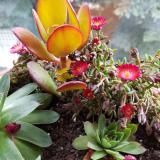
I new added a "Kalanchoe, free from Kensington Florist (not flowering)" in my "garden"


2
0
成长记
raspberry.preserved
2017年09月27日

I new added a "panda plant (kalanchoe tomentosa)" in my "garden"


3
0
文章
Dummer. ゛☀
2017年09月25日

Scientific Name
Kalanchoe delagoensis Eckl. & Zeyh.

Common Names
Chandelier Plant, Mother of Thousands, Mother of Millions
Synonyms
Kalanchoe tubiflora, Kalanchoe verticillata, Kalanchoe delagoensis, Bryophyllum tubiflorum, Bryophyllum verticillatum, Bryophyllum delagoense, Geaya purpurea
Scientific Classification
Family: Crassulaceae
Subfamily: Sedoideae
Tribe: Kalanchoeae
Genus: Kalanchoe

Flower
Flower Color: Orange to scarlet
Bloom Time: Winter
Description
Kalanchoe delagoensis is a perennial succulent, reproducing asexually by means of small plantlets borne at the ends of each leaf. Stem erect, up to 3.3 feet (1 m), often with short sterile shoots at the base. Leaves simple, usually ternate, sub-cylindrical, up to 6 inches (15 cm) long, up to 0.2 inch (0.5 cm) wide, lower surface sulcate, often spotted with reddish brown, margins near apex with 3 – 9 conical teeth between which spoon-shaped bulbils are produced. Umbels of trumpet-shaped up to 1.2 inches (3 cm) long orange to scarlet flowers that dangle in clusters from the top of the plant. Due to intense vegetative reproduction, this plant rarely blooms. But well grown larger specimens can flower profusely in winter.

How to Grow and Care
Kalanchoes are not particularly hard to grow, and the flowering varieties are highly rewarding for their colorful and long-lasting flowers.
They prefer bright, sunny locations, especially in the summer growing season. During the winter, consider a south-facing window. Water moderately throughout the summer and reduce watering in the winter. Let the soil surface dry out between waterings, and in the winter, the plant can almost dry out. Watch the fleshy leaves for signs of water distress. An ordinary potting soil mix is fine. Feed bi-weekly in the summer with a liquid fertilizer, or use slow-release pellets.
Origin
Native to Madagascar.
Kalanchoe delagoensis Eckl. & Zeyh.

Common Names
Chandelier Plant, Mother of Thousands, Mother of Millions
Synonyms
Kalanchoe tubiflora, Kalanchoe verticillata, Kalanchoe delagoensis, Bryophyllum tubiflorum, Bryophyllum verticillatum, Bryophyllum delagoense, Geaya purpurea
Scientific Classification
Family: Crassulaceae
Subfamily: Sedoideae
Tribe: Kalanchoeae
Genus: Kalanchoe

Flower
Flower Color: Orange to scarlet
Bloom Time: Winter
Description
Kalanchoe delagoensis is a perennial succulent, reproducing asexually by means of small plantlets borne at the ends of each leaf. Stem erect, up to 3.3 feet (1 m), often with short sterile shoots at the base. Leaves simple, usually ternate, sub-cylindrical, up to 6 inches (15 cm) long, up to 0.2 inch (0.5 cm) wide, lower surface sulcate, often spotted with reddish brown, margins near apex with 3 – 9 conical teeth between which spoon-shaped bulbils are produced. Umbels of trumpet-shaped up to 1.2 inches (3 cm) long orange to scarlet flowers that dangle in clusters from the top of the plant. Due to intense vegetative reproduction, this plant rarely blooms. But well grown larger specimens can flower profusely in winter.

How to Grow and Care
Kalanchoes are not particularly hard to grow, and the flowering varieties are highly rewarding for their colorful and long-lasting flowers.
They prefer bright, sunny locations, especially in the summer growing season. During the winter, consider a south-facing window. Water moderately throughout the summer and reduce watering in the winter. Let the soil surface dry out between waterings, and in the winter, the plant can almost dry out. Watch the fleshy leaves for signs of water distress. An ordinary potting soil mix is fine. Feed bi-weekly in the summer with a liquid fertilizer, or use slow-release pellets.
Origin
Native to Madagascar.
3
1
文章
Dummer. ゛☀
2017年09月25日

Scientific Name
Kalanchoe blossfeldiana Poelln.

Common Names
Flaming Katy, Christmas Kalanchoe, Florist Kalanchoe, Madagascar Widow’s Thrill
Synonyms
Kalanchoe globulifera var. coccinea
Scientific Classification
Family: Crassulaceae
Subfamily: Sedoideae
Tribe: Kalanchoeae
Genus: Kalanchoe

Flower
Flower Color: Red, yellow, orange, pink, purple, white and variant of these
Bloom Time: Late autumn to early winter
Description
Kalanchoe blossfeldiana is a bushy, evergreen, succulent perennial, up to 1.5 feet (45 cm) tall and up to 1.6 feet (50 cm) wide. The leaves are fleshy, scallop-edged, ovate and dark green in color. The small flowers are arranged in dense clusters. The classic Kalanchoe blossfeldiana‘s flowers consist of four petals that form a tubular-shape flower and can be red, yellow, orange, pink, purple, white and variant of these.

How to Grow and Care
Kalanchoes are not particularly hard to grow, and the flowering varieties are highly rewarding for their colorful and long-lasting flowers. They prefer bright, sunny locations, especially in the summer growing season. During the winter, consider a south-facing window. Water moderately throughout the summer and reduce watering in the winter. Let the soil surface dry out between waterings, and in the winter, the plant can almost dry out. Watch the fleshy leaves for signs of water distress.
Kalanchoes prefer bright, sunny locations, especially in the summer growing season. During the winter, consider a south-facing window. Water moderately throughout the summer and reduce watering in the winter. Let the soil surface dry out between waterings, and in the winter, the plant can almost dry out. Watch the fleshy leaves for signs of water distress. They prefer warmth. Do not let fall below 55ºF (12.7ºC). An ordinary potting soil mix is fine.
Origin
Native to Madagascar.
Kalanchoe blossfeldiana Poelln.

Common Names
Flaming Katy, Christmas Kalanchoe, Florist Kalanchoe, Madagascar Widow’s Thrill
Synonyms
Kalanchoe globulifera var. coccinea
Scientific Classification
Family: Crassulaceae
Subfamily: Sedoideae
Tribe: Kalanchoeae
Genus: Kalanchoe

Flower
Flower Color: Red, yellow, orange, pink, purple, white and variant of these
Bloom Time: Late autumn to early winter
Description
Kalanchoe blossfeldiana is a bushy, evergreen, succulent perennial, up to 1.5 feet (45 cm) tall and up to 1.6 feet (50 cm) wide. The leaves are fleshy, scallop-edged, ovate and dark green in color. The small flowers are arranged in dense clusters. The classic Kalanchoe blossfeldiana‘s flowers consist of four petals that form a tubular-shape flower and can be red, yellow, orange, pink, purple, white and variant of these.

How to Grow and Care
Kalanchoes are not particularly hard to grow, and the flowering varieties are highly rewarding for their colorful and long-lasting flowers. They prefer bright, sunny locations, especially in the summer growing season. During the winter, consider a south-facing window. Water moderately throughout the summer and reduce watering in the winter. Let the soil surface dry out between waterings, and in the winter, the plant can almost dry out. Watch the fleshy leaves for signs of water distress.
Kalanchoes prefer bright, sunny locations, especially in the summer growing season. During the winter, consider a south-facing window. Water moderately throughout the summer and reduce watering in the winter. Let the soil surface dry out between waterings, and in the winter, the plant can almost dry out. Watch the fleshy leaves for signs of water distress. They prefer warmth. Do not let fall below 55ºF (12.7ºC). An ordinary potting soil mix is fine.
Origin
Native to Madagascar.
4
2
文章
Dummer. ゛☀
2017年09月23日

Kalanchoe is a succulent plant valued for its vivid, bright colors, and tightly clustered bouquets of little flowers. It’s hardy in USDA zones 10 through 12, but makes an excellent indoor plant. Kalanchoe flowers can start losing their vibrancy in the second and third years of growth, but propagation methods are easy and can produce young, healthy varieties that grow from 36 to 48 inches (90 to 120 cm). The seeds from cross-pollination can produce some interesting hybrids as well, but there’s no guarantee that there will be a particular resemblance to the parent plants. If you want to give it a try and see what you get, seed propagation is right for you. If you would rather have more of the same plant, you can propagate Kalanchoe plants by using cuttings.
Seeds
Kalanchoe seeds are tiny, around 2.5 million per ounce. When you propagate Kalanchoe with seeds, you’ve got two options. The first is to purchase seeds from your local garden center or nursery. The second is to cross-pollinate two Kalanchoe or more in your perennial flower garden if you have them. You can crossbreed the two varieties and come up with a hybrid that can either have traits of the parent plants, traits of its own, or both. It’s always exciting to see what crossbreeding two Kalanchoe plants will bring you, and what colors you’ll see in your shrub.
To crossbreed, wait until you have two or more plants in full bloom. Use a small paintbrush or Q-tip to brush pollen from the stamen of one flower to the stigma of another, transferring from plant to plant. Since the flowers come in crowded bundles, it may be easiest to cut off a clump of them and pull them apart to get to the pollen.
The Kalanchoe seeds can go directly into warm, slightly moist soil made of half cactus mix and half fine potting soil. The warmth and the humidity of the dirt will activate the seed’s growth hormones and guide the sprout towards nutrients, thus giving you a baby Kalanchoe sprout.
Seeds should be placed in indirect light and kept at temperatures between 70 and 75 degrees Fahrenheit (21 and 24 degrees Celsius). Fill a clean spray bottle with filtered or rain water and mist the seeds only when the soil appears dry. Do not over water! Germination should take around 10 days. Pinch the seedling back lightly at six to eight weeks. When they are 6 inches (15 cm) high, transplant the seedlings to their own individual 1 to 2-inch (2.5 to 5 cm) pots and follow the care instructions below.
Leaf Cuttings
If you want to have the exact same plant in repetition in your garden, you can propagate Kalanchoe with leaf cuttings. Take your cuttings in early spring, using a pair of sharp garden shears to cut a few strong green shoots off of the Kalanchoe, 6 to 9 inches (15 to 22.5 cm) long. Strip the leaves off of the bottom 3 inches (7.5 cm) of the cutting. You should allow the cuttings to dry on the counter for around three days to let the cut side heal up. If you plant the cutting immediately, it will be susceptible to rot.
The soil requirement for cutting propagation is a cactus mix blended with some humus topsoil. Before planting, water the mix thoroughly and allow it to drain for half an hour so that the soil is moist for planting. Dig a small hole and stand the cutting upright, filling the hole in and pressing firmly so that it stands up on its own.
Avoid watering the Kalanchoe cutting for at least one week. This encourages the leaf to survive in rather dry conditions by rooting through the soil. The dirt you use should be permeable, well-drained and never overwatered. You should attempt to propagate multiple cuttings to achieve at least one viable seedling. Small plants will begin to grow from the base of the cutting after one month. Keep the seedlings moist, spraying them with filtered or rain water, but never letting it puddle.
Seedling Care
After a month or two gently dig the little Kalanchoe plants from their potting mix and transplant them into individual 1 or 2-inch (2.5 or 5 cm) pots. Fill the pots with a mix of coarse sand, peat moss, and compost. Always put an inch of pebbles or broken pottery in the bottom of the pot to improve drainage. They can now be treated like mature plants.
Kalanchoe need temperatures of between 60 and 85 degrees Fahrenheit (15 and 30 degrees Celsius) to thrive, and repeated exposure to colder temperatures will kill it. Keep your indoor Kalanchoe away from doors or drafts during the winter and consider using a radiator or small heating pad set on low to maintain these temperatures.
Kalanchoe love sun, but avoid direct sunlight in the summer when it can scald them. These environmental parameters should be used until transplantation. Your plants generally won’t be ready for a permanent home in your garden until they’re about two or three years old. They need to be between the adolescent and mature stage so that transplanting doesn’t shock the plant to death. If you do not live in UDSA hardiness zones 10 through 12, you have to keep your Kalanchoe as a houseplant permanently. Allow the soil to become dry between watering to avoid root rot, a common problem.
Whichever way you choose to propagate your Kalanchoe, you can reap all of the benefits of this low-maintenance plant. You can re-bloom it, you can gift adolescent plants to someone else to care for, and you can even forget to water them sometimes—they’ll forgive you, and they’ll even reward you with more blooms.

Seeds
Kalanchoe seeds are tiny, around 2.5 million per ounce. When you propagate Kalanchoe with seeds, you’ve got two options. The first is to purchase seeds from your local garden center or nursery. The second is to cross-pollinate two Kalanchoe or more in your perennial flower garden if you have them. You can crossbreed the two varieties and come up with a hybrid that can either have traits of the parent plants, traits of its own, or both. It’s always exciting to see what crossbreeding two Kalanchoe plants will bring you, and what colors you’ll see in your shrub.

To crossbreed, wait until you have two or more plants in full bloom. Use a small paintbrush or Q-tip to brush pollen from the stamen of one flower to the stigma of another, transferring from plant to plant. Since the flowers come in crowded bundles, it may be easiest to cut off a clump of them and pull them apart to get to the pollen.
The Kalanchoe seeds can go directly into warm, slightly moist soil made of half cactus mix and half fine potting soil. The warmth and the humidity of the dirt will activate the seed’s growth hormones and guide the sprout towards nutrients, thus giving you a baby Kalanchoe sprout.

Seeds should be placed in indirect light and kept at temperatures between 70 and 75 degrees Fahrenheit (21 and 24 degrees Celsius). Fill a clean spray bottle with filtered or rain water and mist the seeds only when the soil appears dry. Do not over water! Germination should take around 10 days. Pinch the seedling back lightly at six to eight weeks. When they are 6 inches (15 cm) high, transplant the seedlings to their own individual 1 to 2-inch (2.5 to 5 cm) pots and follow the care instructions below.

Leaf Cuttings
If you want to have the exact same plant in repetition in your garden, you can propagate Kalanchoe with leaf cuttings. Take your cuttings in early spring, using a pair of sharp garden shears to cut a few strong green shoots off of the Kalanchoe, 6 to 9 inches (15 to 22.5 cm) long. Strip the leaves off of the bottom 3 inches (7.5 cm) of the cutting. You should allow the cuttings to dry on the counter for around three days to let the cut side heal up. If you plant the cutting immediately, it will be susceptible to rot.

The soil requirement for cutting propagation is a cactus mix blended with some humus topsoil. Before planting, water the mix thoroughly and allow it to drain for half an hour so that the soil is moist for planting. Dig a small hole and stand the cutting upright, filling the hole in and pressing firmly so that it stands up on its own.

Avoid watering the Kalanchoe cutting for at least one week. This encourages the leaf to survive in rather dry conditions by rooting through the soil. The dirt you use should be permeable, well-drained and never overwatered. You should attempt to propagate multiple cuttings to achieve at least one viable seedling. Small plants will begin to grow from the base of the cutting after one month. Keep the seedlings moist, spraying them with filtered or rain water, but never letting it puddle.

Seedling Care
After a month or two gently dig the little Kalanchoe plants from their potting mix and transplant them into individual 1 or 2-inch (2.5 or 5 cm) pots. Fill the pots with a mix of coarse sand, peat moss, and compost. Always put an inch of pebbles or broken pottery in the bottom of the pot to improve drainage. They can now be treated like mature plants.

Kalanchoe need temperatures of between 60 and 85 degrees Fahrenheit (15 and 30 degrees Celsius) to thrive, and repeated exposure to colder temperatures will kill it. Keep your indoor Kalanchoe away from doors or drafts during the winter and consider using a radiator or small heating pad set on low to maintain these temperatures.

Kalanchoe love sun, but avoid direct sunlight in the summer when it can scald them. These environmental parameters should be used until transplantation. Your plants generally won’t be ready for a permanent home in your garden until they’re about two or three years old. They need to be between the adolescent and mature stage so that transplanting doesn’t shock the plant to death. If you do not live in UDSA hardiness zones 10 through 12, you have to keep your Kalanchoe as a houseplant permanently. Allow the soil to become dry between watering to avoid root rot, a common problem.

Whichever way you choose to propagate your Kalanchoe, you can reap all of the benefits of this low-maintenance plant. You can re-bloom it, you can gift adolescent plants to someone else to care for, and you can even forget to water them sometimes—they’ll forgive you, and they’ll even reward you with more blooms.
1
0
文章
Dummer. ゛☀
2017年09月23日

Kalanchoe blossfeldiana, also known as Flaming Katy is a tropical succulent that is native to Madagascar. This flowering plant is most commonly grown as a houseplant but grows well outdoors in U.S. Department of Agriculture plant hardiness zones 10 and 11. A short-day plant, Flaming Katy produces blooms during the winter months. Young Flaming Katy plants have smooth stems and thick leaves. The plant roots readily from a vegetative shoot and many growers use this type of propagation for Kalanchoe blossfeldiana production. Commercial growers use intermittent mist and heat mats to propagate Flaming Katy, but you can make Flaming Katy cuttings without a professional setup.
1. Cut cleanly through a vegetative stem of the Kalanchoe blossfeldiana. This is a stem that has no flower growth. Make the cutting at least 3 inches (8 cm) long. Set the cutting in an empty pot for two or three days to allow a callous to form over the cut flesh of the stem. The callous keeps the cutting from rotting in the growing medium.
2. Mix together equal parts of sand, perlite and peat moss to create a quality growing medium for Flaming Katy cuttings. Fill a sterile pot with the growing medium and water the medium lightly. The size of the pot dictates how many cuttings you root per pot. Pots that are 3 or 4 inches (8 or 10 cm) around hold one cutting, while 5- or 6-inch (13 or 15 cm) pots hold two or three cuttings.
3. Make a hole in the growing medium and stick the calloused cutting into the hole. Firm the soil around the cutting to keep the Flaming Katy upright. Set the pot in a bright location that has an average temperature of about 70 degrees Fahrenheit (21 degrees Celsius). Avoid direct sunlight on the cuttings.
4. Mist the cuttings several times per day. Remove cuttings that show signs of fungal growth. Check for roots after about two weeks. Gently pull on the cuttings to feel for some type of resistance that would signify root growth.
5. Transplant the new Kalanchoe blossfeldiana plants into separate growing pots when the roots have reached about 1 inch (2.5 cm) in length. Treat the plant as a seedling for the first few weeks. In other words, avoid drafts, direct sunlight and drought conditions. When you see new growth on the Flaming Katy plants, place them as desired in the home.

1. Cut cleanly through a vegetative stem of the Kalanchoe blossfeldiana. This is a stem that has no flower growth. Make the cutting at least 3 inches (8 cm) long. Set the cutting in an empty pot for two or three days to allow a callous to form over the cut flesh of the stem. The callous keeps the cutting from rotting in the growing medium.

2. Mix together equal parts of sand, perlite and peat moss to create a quality growing medium for Flaming Katy cuttings. Fill a sterile pot with the growing medium and water the medium lightly. The size of the pot dictates how many cuttings you root per pot. Pots that are 3 or 4 inches (8 or 10 cm) around hold one cutting, while 5- or 6-inch (13 or 15 cm) pots hold two or three cuttings.

3. Make a hole in the growing medium and stick the calloused cutting into the hole. Firm the soil around the cutting to keep the Flaming Katy upright. Set the pot in a bright location that has an average temperature of about 70 degrees Fahrenheit (21 degrees Celsius). Avoid direct sunlight on the cuttings.
4. Mist the cuttings several times per day. Remove cuttings that show signs of fungal growth. Check for roots after about two weeks. Gently pull on the cuttings to feel for some type of resistance that would signify root growth.

5. Transplant the new Kalanchoe blossfeldiana plants into separate growing pots when the roots have reached about 1 inch (2.5 cm) in length. Treat the plant as a seedling for the first few weeks. In other words, avoid drafts, direct sunlight and drought conditions. When you see new growth on the Flaming Katy plants, place them as desired in the home.
1
1



